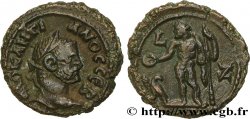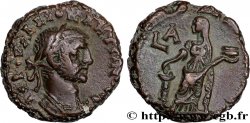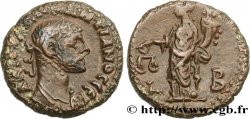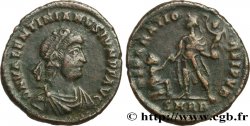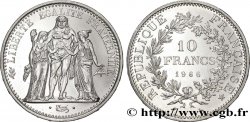v21_3392 - DIOCLEZIANO Aurelianus
MONNAIES 21 (2004)
Prezzo di inizio : 100.00 €
Valutazione : 150.00 €
Prezzo realizzato : 110.00 €
Numero di offerte : 2
Offerta maxima : 110.00 €
Prezzo di inizio : 100.00 €
Valutazione : 150.00 €
Prezzo realizzato : 110.00 €
Numero di offerte : 2
Offerta maxima : 110.00 €
Tipo : Aurelianus
Data: été 287
Nome della officina / città: Gaule, Lyon (Lugdunum)
Metallo : billone
Titolo in millesimi : 50 ‰
Diametro : 22 mm
Asse di coniazione : 5 h.
Peso : 4,03 g.
Officine: 1re
Emission: 4e
Commenti sullo stato di conservazione:
Beau portrait. Flan large et ovale. Patine marron avec des reflets métalliques. Joli revers
N° nelle opere di riferimento :
Diritto
Titolatura diritto : IMP C C VAL DIOCLETIANVS P F AVG.
Descrittivo diritto : Buste radié, drapé et cuirassé de Dioclétien à droite, vu de trois quarts en arrière (A2).
Traduzione diritto : “Imperator Cæsar Caius Valerius Diocletianus Pius Felix Augustus”, (L'empereur césar Caius Valère Dioclétien pieux et heureux auguste).
Rovescio
Titolatura rovescio : IOVI CONSE-R AVGG/ -|A//SML.
Descrittivo rovescio : Jupiter debout à gauche, le manteau sur l'épaule gauche, tenant un foudre de la main droite et un sceptre de la main gauche ; à ses pieds, un aigle debout à gauche tournant la tête à droite.
Traduzione rovescio : “Iovi Conservatori Augustorum”, (À Jupiter conservateur des augustes).
Commento
Pour le Bas Empire, de Dioclétien à la fin de l’Empire, le classement repose sur les travaux du Dr P. Bastien pour l’atelier de Lyon publiés depuis 1972. Pour les autres ateliers, le classement est basé sur l’ouvrage fondamental, the Roman Imperial Coinage, RIC. volumes 6, 7, 8, 9 et 10, qui couvrent la période comprise entre la Réforme monétaire de Dioclétien en 294 et la fin de l’Empire Romain en 491 à la mort de Zénon. Pour le monnayage de bronze, l’ouvrage de référence reste celui de R. A. G. Carson, P. V. Hill et J. P. C. Kent, Late Roman Bronze Coinage, Londres 1978.
For the Late Empire, from Diocletian to the end of the Empire, the classification is based on the work of Dr. P. Bastien for the Lyon mint published since 1972. For the other mints, the classification is based on the fundamental work, the Roman Imperial Coinage, RIC. volumes 6, 7, 8, 9 and 10, which cover the period between the monetary reform of Diocletian in 294 and the end of the Roman Empire in 491 at the death of Zeno. For bronze coinage, the reference work remains that of RAG Carson, PV Hill and JPC Kent, Late Roman Bronze Coinage, London 1978
For the Late Empire, from Diocletian to the end of the Empire, the classification is based on the work of Dr. P. Bastien for the Lyon mint published since 1972. For the other mints, the classification is based on the fundamental work, the Roman Imperial Coinage, RIC. volumes 6, 7, 8, 9 and 10, which cover the period between the monetary reform of Diocletian in 294 and the end of the Roman Empire in 491 at the death of Zeno. For bronze coinage, the reference work remains that of RAG Carson, PV Hill and JPC Kent, Late Roman Bronze Coinage, London 1978







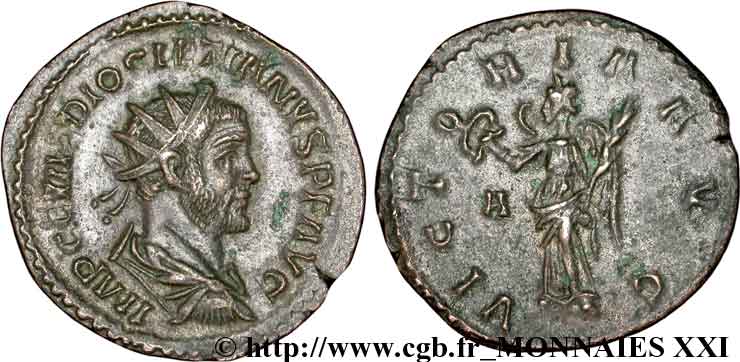
 Segnalare un errore
Segnalare un errore Stampate la pagina
Stampate la pagina Condividi mia selezione
Condividi mia selezione Fai una domanda
Fai una domanda Consegnare / vendere
Consegnare / vendere
 Descrittivo
Descrittivo
